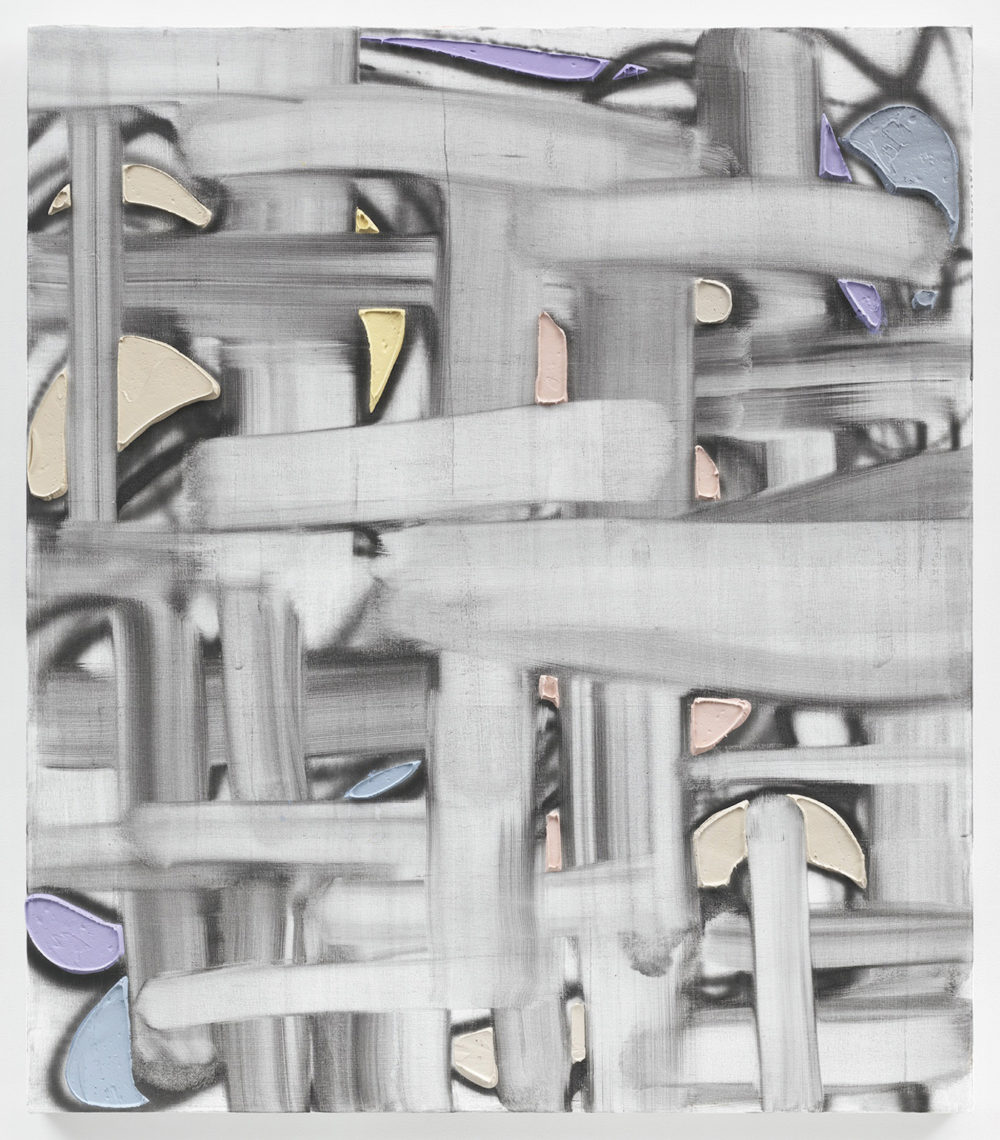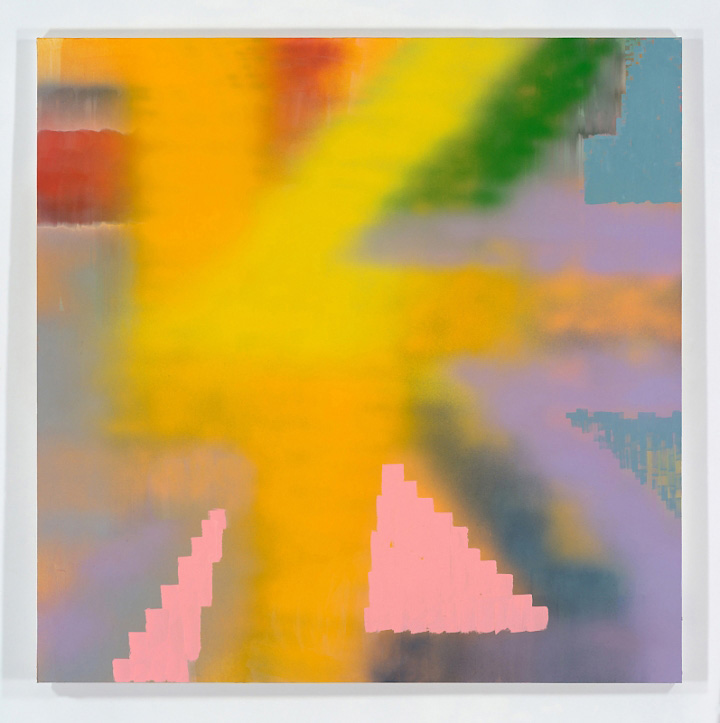
- Source: Hyperallergic
- Author: JASON STOPA
- Date: January 06, 2018
- Format: DIGITAL
Painting as Total Environment
Laura Owens, Keltie Ferris, Rachel Rossin, and Trudy Benson are exploring hybrid paintings that rival sculpture in their tactility, illusion, and physical depth.
In the past few years, there has been an uptick in an expanded form of painting that presents itself as a hybrid. A few current examples of this tendency include the work of Laura Owens, Keltie Ferris, Rachel Rossin, and Trudy Benson — artists who have explored multi-media paintings that rival sculpture. These works feel constructed as opposed to made, and engage with several forms of tactility, illusion, and physical depth.
In a time in which younger artists continue to churn out sanctioned modernist tropes to continuously diminishing returns, the natural question to ask is: why would some contemporary painters resort to a multi-faceted approach that can feel, in many respects, entirely preconceived?
This very approach might have something to do with the influence of performance invading the space of painting, in which mark-making is liberated from the traditional formal unity that previous paintings occupy.
This tendency is not entirely new. Rather, we can trace its antecedents to the funky, shaped, theatrical, baroque canvases of Elizabeth Murray and Frank Stella in the 1980s, both of whom had major exhibitions in New York in the past two years, at Pace Gallery and the Whitney Museum of American Art, respectively. Those works grappled with the architectural space of the gallery and the conventions of a rectangular support, merging both geometric and expressive tendencies into a multi-planar site.

Keltie Ferris, “Gray Matter” (2017), oil and acrylic on canvas, 40 1/4 x 35 1/8 inches, image courtesy of the artist and Mitchell-Innes & Nash, New York
Another tendency is evident in the deterministic, heavily impastoed paintings of Jonathan Lasker, Bram Bogart and Peter Halley. Lasker is interested in the division between drawing, mark-making and gesture – parsing each out of its nestled union and superimposing them onto a field. Both Lasker’s and Bogart’s marks “perform” as actors in space, with gestures that have been blown up, beyond life-size. Halley’s recent solo exhibit at Greene Naftali was composed of three separate rooms and one outdoor work. The walls of the first two rooms were painted in varying colors, and used distinct lighting effects. The third room housed his paintings, which featured his motifs of the cell and conduit.
Such an exhibition staged a kind of pictorialism, wherein the architectural space becomes a site-specific environment; an idea that artists such as Mary Heilmann and Chris Ofili have also considered. At her solo exhibit in 2009 at 303 Gallery, Heilmann introduced painted chairs alongside her paintings, which acted as both functional support and aesthetic intervention into the space. Ofili’s 2014 retrospective at The New Museum featured a room with extremely low lighting. The works in that room used a type of paint that could be seen only under such light, which in turn demanded that viewers move around the exhibition space both to accommodate themselves to the darkness and to view the paintings. My own work often employs a similar language – a painted wall or “stage” that will hold individual canvases while altering the spatial relationship between them, even as it references the imagery found in the paintings.
The lineage for this approach goes even farther back than Murray and Stella, however, to include the paintings/performances of the Gutai group in Japan and Support/Surface in France, two of the more overlooked tendencies during the height of Color Field Painting and Minimalism. Here, the influence is more conceptual than aesthetic. Gutai paintings were the result of a surface being heavily manipulated by human presence, in which the body is used as brush or mark-making device, resulting in a hybrid object somewhere between the act of painting and the action of the body.
As the Gutai group stated in its manifesto, its aim was “to go beyond abstraction” and “to pursue enthusiastically the possibilities of pure creativity.” The text declared “that by merging human qualities and materials properties, we can concretely comprehend abstract space.” Such spatial concerns are part of the impulse running through the work of painters today. Support Surface artists often used handkerchiefs, gauze, tents, tarps and unstretched canvas to create works that hang on walls, unroll onto the floor, or sit on the ground like a sculpture. In this way, the artists of Support/Surface revealed the artifice behind all paintings, enacting a form of radical deconstruction in which paintings perform their utility. In both of these movements, painting’s ontological status is thoroughly dissected that , it was now up to a future generation to reconstitute it in a new form.
What expanded painting does most effectively is embrace performance within the staged site of the exhibition space, thus merging painting and its surrounding space into a total environment. As Mark Titmarsh notes in his book Expanded Painting: Ontological Aesthetics and the Essence of Colour (2017), where abstract painting could once only reach out to what it constitutes on a material level, it can now reference everything it is not: sculpture, photography, digital media, video, performance, VR, and so forth.
The promotional material on the website of the virtual reality developer Oculus Rift makes some lofty, near-utopian claims, promising users an experience unlike anything else. I would argue that a similar claim with respect to painting could be made for the work of these four artists: Trudy Benson, Keltie Ferris, Laura Owens and Rachel Rossin.
Rossin is one of many recent artists, though the only one of these four, to actively engage with VR, yet she remains a painter. For a 2015 solo show at Signal Gallery, she scanned bits of her paintings — quasi-abstractions with some recognizable imagery — and other images from her studio and apartment to create a short video. Viewers had to use a Rift headset, through which they were thrust into a disparate environment of fragmented forms that occasionally dissolve into white, negative space. Attempting to locate themselves somewhere between the painting/apartment, the negative space, and their own bodily experience as they navigate the virtual space, viewers enter a fourth dimension that goes beyond traditional conventions of a physical encounter with a static, painted object in space and time.
Trudy Benson is a painter whose work draws its worldview from technology and science. Initially, her paintings referenced digital imaging programs, but it is now invested in paintings’ retinal functions. Her exhibition at Half Gallery in 2016, Spooky Action at a Distance, borrowed its title from quantum physics, an appropriate reference given the uncanny nature of the paintings. Benson’s work is indebted to the playful, illusionistic cartooning of Elizabeth Murray, but she departs from Murray’s influence in that her work returns to the rectangle and achieves illusion through layering. Benson also flirts with decoration, another narrative cast aside as pejorative in the history of modernism. Airbrushed atmospheres, gradients, hypnotic curlicues, industrial roller marks, thin skeins of paint, paint squeezed directly out of a tube — Benson knows that each of these techniques creates a discrete physical sensation of create ocular depth and tactility that belies the flatness of the canvas. Such an approach collapses the natural capacity to easily apprehend an image.

Keltie Ferris, “+/-“ (2016), oil and acrylic on canvas, 90 x 90 inches, image courtesy of the artist and Mitchell-Innes & Nash, New York
Of all the artists in this grouping, Keltie Ferris provides the most direct link to the interests of Gutai. In her large, multi-media works, vivid spray-painted, translucent atmospheres are contrasted with opaque, hand-painted geometric areas reminiscent of pointillism or pixelation, a juxtaposition that creates significant spatial depth Recent works such as “Gray Matter” (2017) inhabit an intersection between the theatrical baroque and the graphic specificity of stained glass, which is accentuated a dynamic sense of movement, swirling spirals, upward diagonals, and heavy impasto. In her exhibition last year at Mitchell-Innes & Nash on Madison Ave, she displayed her body prints, made by covering her body in oils and pigments and then pressing it against the surface of canvas or paper. These works act as both a marker of identity and an index of an action, quite literally reimagining the idea of action painting. Though the artist is quite present in these works, they are not about the figure as much as they are about the body.
The paintings of Laura Owens take a different take on the humorous, near-tacky effects of Abstract Illusionism and the hybrid aesthetic of the 1980s painting/sculptures of Frank Stella. As evidenced by the paintings in her current retrospective at the Whitney, she keeps a toolshed of effects and objects — drop shadows, large modernist grids, drips, bicycle wheels, squiggles, text, impasto that rivals cake frosting, and even wallpaper – that appear predetermined to keep every possible idea of “mark-making” alive. It is a kitchen sink approach, incorporating painted walls and bedroom sets. If painting is thoroughly divested of discourse – no Greenbergian formalism, no end-of-painting narrative — then all of paintings’ potentialities are up for grabs. The result is a kind of theater of painting. And what’s at stake in this play is a painting-meets-Dada gesture — an overthrow of the canon of taste. Meanwhile the resulting paintings offer a clever, albeit funny, sophistication and mastery of technique.
If there is an aesthetic thread that knits these artists together, it’s the fact that their paintings are front-loaded with successive layers announcing their physical and optical presence. Still, their imagery manages to recede into a deep, fractured space that implicates both the eye and the body. This sense of fractured painterly space might have something to do with the disconnect between embodied looking and the visual network to which so much imagery now belongs – compressed jpegs that partially represent the characteristics of real things, but can never deliver their fullness. In a time when few painters seem concerned with the problems or progress of painting, a group appears on the scene ready to reach out to the peripheries of its territory, and thereby expand its language. This is expanded painting.

